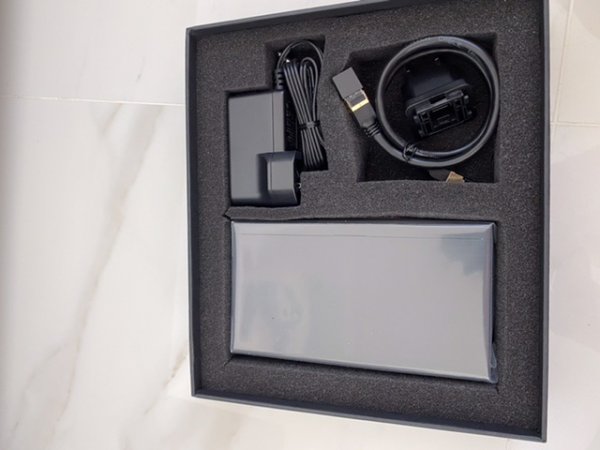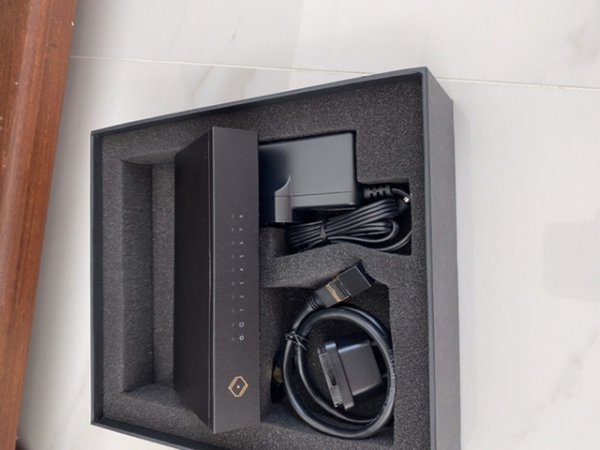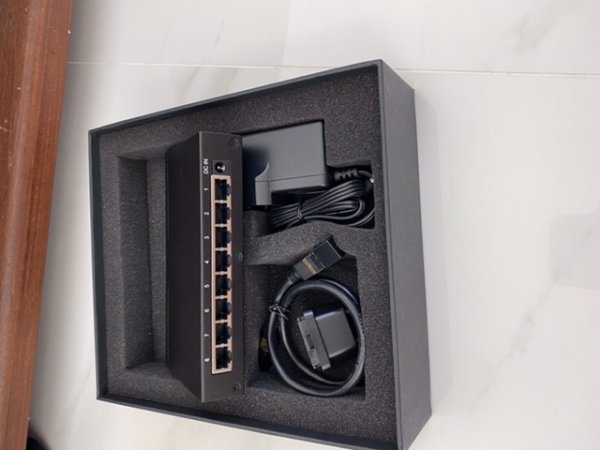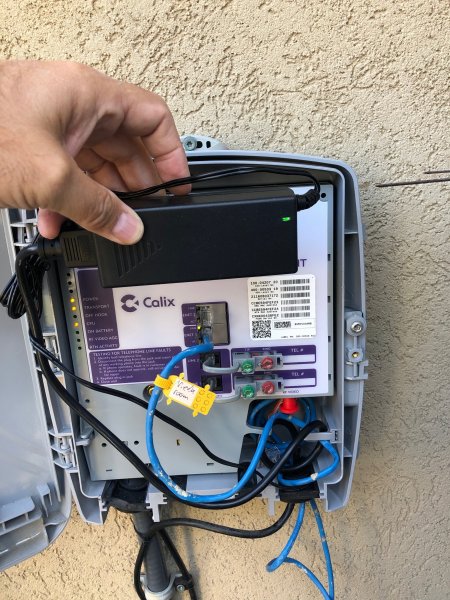Network Improvements and their Impact on Sound Quality
- Thread starter Blackmorec
- Start date
-
- Tags
- music streaming network
You are using an out of date browser. It may not display this or other websites correctly.
You should upgrade or use an alternative browser.
You should upgrade or use an alternative browser.
When you say FS brand transceiver do you mean Finisar?SM Fiber is the standard for Multimedia communications
MM Fiber was developed only to lower cost facilitate terminations and for short distances.
SM Glass Fiber is about 10 Micron, MM is about 100 microns so if you compare the area we are talking 78.54 ?m² vs 7,854 ?m²
SM cables can transmit data faster, longer distances because they generate much less distortion than MM fibers, since in MM the signal is constantly bouncing.
In any lab test in a control environment regardless of cable length, and using perfectly terminated high quality fiber cables, a SM cable will outperform an equivalent MM cable in every single aspect, specially data integrity, bit errors, timing errors and distortion. So if someone feels a MM sound better than the SM, it might be the MM Cable is better terminated or the quality of the equipment/transceiver used with the MM was better, there can be hundreds of variables LOL.
I Spent my work days designing large and complex Fiber networks LOL!
BTW Few Tips
Limit Media Conversions - The thing that affect the most a network signal integrity is conversion going back and forward between, fiber --> copper --> fiber --> copper LOL will degrade the signal more than adding 100 meters of Cat7A cable LOL.
Use high Quality Transceiver - If you are going to convert use a good transceiver, remember the transceiver is what actually convert the light to pulses and vice-versa is not your switch or EtheRegen! Don't use FS brand a good HP or Cisco will outperform them and are much more reliable.
And Lastly, Those Bulky nice looking Field install IP20 cat 7A or Cat 8 plugs that high end cable use are some of the worst performer connectors available! We did a large test at our ISP and we used a top of the line Anritsu NA and the best performance on Cat 7a and 8 cable termination was achieved using the Platinum tools ezEX48 crimp plug LOL! Believe it or Not LOL! we tested it like 10 times LOL.
The reason is very simple and obvious, the weakest links in any cable are connectors and signal medium.
Signal flow in a Crimp plug: spring bars --> Plug pins (gold bars on the plug) --> Wire That's it the cable is directly crimped to the pin that connects to the jack spring bars
Signal flow in a IP20 Field plug: spring bars --> Plug pins (gold bars on the plug) --> Solder connection to PCB traces --> PCB Traces --> Solder connection to IDC Crimp Connector --> wire! LOL
Once we saw this we immediately understood why a high quality crimp plug outperformed the Field install ones.
There is always that misconception that because something is bulkier, more expensive is better for everything! IP 20 Field plugs are designed to meet 2 requirements, IP20 environment certification and to be easy to install with no tools. They are not designed to have better signal performance.
Just like some Aerospace Cat7 cable we tested From Gore Technologies, very expensive cable ($27 a feet bulk) Silver plated wires all Teflon insulated with Teflon tape around even the shield was silver plated, But it end up at the bottom in performance, because is not designed for that!
First the conductors are stranded not solid (bad for performance but great for reliability and flexibility) and the silver plated wires and Teflon insulation was not designed for performance but for High temperature resistance in space.
SM Fiber is the standard for Multimedia communications
MM Fiber was developed only to lower cost facilitate terminations and for short distances.
This is a great post, @audiogurujax, but I’m still wondering. SM by design is meant to drive much longer distances. Even an LR type SM SFP is rated to drive up to 10Km. Let’s not even talk about a ZR. Most audio homes would be hard pressed to have a fiber run much much beyond 10 or 20 meters. Isn’t there a risk of overdriving the receiver with an excessively high optical power level?
I looked into this some more. If the information I found is correct, a short range (10Km) SM transceiver typically outputs at -3dBm. A MM transceiver will output at -4dBm. So there’s virtually no difference in power level between MM and short range SM. I ordered a couple of Cisco GLC-LH-SMD transceivers and a 9M run of SM cable to try out.
Well, that was an interesting experiment. I replaced the SFP MM media converter from my SB8200, and the 10Gtek SFP on the other end (in my Edgerouter4) with a Startech media converter outfitted with a Cisco GLC-LH-SMD, and another one at the ER4 end. In between was 9M of SM cable.
As this is the main link from my cable modem to the rest of my home network, the primary goal was to insure not sonic improvement, but no impact to the reliability and speed of my connection. And this is where this experiment was not giving me the result I was hoping for. Swapping the MM and SM links back and forth over the same stretch of time, using Speedtest to the same endpoint server to test my link speed, yielded worse results with the SM interface. Not just slower, to the order of ~40 Mbps, but also with a significantly higher variance.
I ran Speedtest a few dozen times for either configuration. As noted, the SM was on average about 40Mbps slower, and the variance from the slowest observed speed to the highest was about 180Mbps. By comparison, the variance with MM measured over this same stretch of time was about 30Mbps. Since this is a new networking solution in my new home, I’ve been checking it quite often. The sped and variance number for the MM setup are consistent with what I’ve been seeing the whole time.
Without yet knowing why this reduced and less stable performance was occurring with the SM solution, I’m not willing to make this the way I’m breaking the main network link from my cable modem.
As this is the main link from my cable modem to the rest of my home network, the primary goal was to insure not sonic improvement, but no impact to the reliability and speed of my connection. And this is where this experiment was not giving me the result I was hoping for. Swapping the MM and SM links back and forth over the same stretch of time, using Speedtest to the same endpoint server to test my link speed, yielded worse results with the SM interface. Not just slower, to the order of ~40 Mbps, but also with a significantly higher variance.
I ran Speedtest a few dozen times for either configuration. As noted, the SM was on average about 40Mbps slower, and the variance from the slowest observed speed to the highest was about 180Mbps. By comparison, the variance with MM measured over this same stretch of time was about 30Mbps. Since this is a new networking solution in my new home, I’ve been checking it quite often. The sped and variance number for the MM setup are consistent with what I’ve been seeing the whole time.
Without yet knowing why this reduced and less stable performance was occurring with the SM solution, I’m not willing to make this the way I’m breaking the main network link from my cable modem.
To the folks using Finisar transceivers, did you notice any break in with them?
Mine needed 2 weeks
SM Fiber is the standard for Multimedia communications
MM Fiber was developed only to lower cost facilitate terminations and for short distances.
SM Glass Fiber is about 10 Micron, MM is about 100 microns so if you compare the area we are talking 78.54 ?m² vs 7,854 ?m²
SM cables can transmit data faster, longer distances because they generate much less distortion than MM fibers, since in MM the signal is constantly bouncing.
In any lab test in a control environment regardless of cable length, and using perfectly terminated high quality fiber cables, a SM cable will outperform an equivalent MM cable in every single aspect, specially data integrity, bit errors, timing errors and distortion. So if someone feels a MM sound better than the SM, it might be the MM Cable is better terminated or the quality of the equipment/transceiver used with the MM was better, there can be hundreds of variables LOL.
I Spent my work days designing large and complex Fiber networks LOL!
BTW Few Tips
Limit Media Conversions - The thing that affect the most a network signal integrity is conversion going back and forward between, fiber --> copper --> fiber --> copper LOL will degrade the signal more than adding 100 meters of Cat7A cable LOL.
Use high Quality Transceiver - If you are going to convert use a good transceiver, remember the transceiver is what actually convert the light to pulses and vice-versa is not your switch or EtheRegen! Don't use FS brand a good HP or Cisco will outperform them and are much more reliable.
And Lastly, Those Bulky nice looking Field install IP20 cat 7A or Cat 8 plugs that high end cable use are some of the worst performer connectors available! We did a large test at our ISP and we used a top of the line Anritsu NA and the best performance on Cat 7a and 8 cable termination was achieved using the Platinum tools ezEX48 crimp plug LOL! Believe it or Not LOL! we tested it like 10 times LOL.
The reason is very simple and obvious, the weakest links in any cable are connectors and signal medium.
Signal flow in a Crimp plug: spring bars --> Plug pins (gold bars on the plug) --> Wire That's it the cable is directly crimped to the pin that connects to the jack spring bars
Signal flow in a IP20 Field plug: spring bars --> Plug pins (gold bars on the plug) --> Solder connection to PCB traces --> PCB Traces --> Solder connection to IDC Crimp Connector --> wire! LOL
Once we saw this we immediately understood why a high quality crimp plug outperformed the Field install ones.
There is always that misconception that because something is bulkier, more expensive is better for everything! IP 20 Field plugs are designed to meet 2 requirements, IP20 environment certification and to be easy to install with no tools. They are not designed to have better signal performance.
Just like some Aerospace Cat7 cable we tested From Gore Technologies, very expensive cable ($27 a feet bulk) Silver plated wires all Teflon insulated with Teflon tape around even the shield was silver plated, But it end up at the bottom in performance, because is not designed for that!
First the conductors are stranded not solid (bad for performance but great for reliability and flexibility) and the silver plated wires and Teflon insulation was not designed for performance but for High temperature resistance in space.
LOL
Thanks. Good to know. They sound pretty edgy now.Mine needed 2 weeks
Never.To the folks using Finisar transceivers, did you notice any break in with them?
Thanks. Good to know. They sound pretty edgy now.
It sounds from what you say they are not braked in .
I got 8 used Finisar SFPs and they are so fulid and airly without The edges.
I tried Finisar, Planet and StarTech .
For few months I was thinking Finisar is a way to go and the best SFP available.
But I kept the 80 km Startech 1550 and after the Emile upgrade to my extreme
I was able to retest all 3 SFPs .
StarTech that Emile recommended to me a year ago was a clear winner with fantastic authority
and precision that is NOT reachable by other 2.
But the true game changer in my system was the addition of Pink Faun Ultra clocks to the Buffalo 2016
Lets call it PFU Buffalo.
Nenon was the first to try to use this clock in Buffalo 2016 switch and he really likes it.
He was stacking them for better results upto 6 of them.
Austinpop (Rajiv) was tesing this switch (PFU Buffalo borrowed fron Nenon) extensively and it was a clear winner in his precise testing Against the other switches he had including Sotm .
Additionally Nenon retested PFU Buffalo against the Telegartner M12 and he would still prefer the PFU Buffalo (60%) than Telegartner M12(40%). That is a very good news .
Personally I have 2 PFU Buffalows that I got upgrated with help of Jord from Pink Faun,
and 2 standard Buffalows + an Ether Regen I was not using for some time.
I use All of them (5) stacked now with great result.
Planning to collect more cash for the other 2 Buffalows to get Pink Faun Ultra clocks installed.
I also plan to upgrate the Router clock and modem clocks with PinkFaun ultra.
The result must be positive but not sure what to expect 10% or 100% increase in SQ.
Tests will tell us if it is worth.
I will try to report in few weeks.
Lets call it PFU Buffalo.
Nenon was the first to try to use this clock in Buffalo 2016 switch and he really likes it.
He was stacking them for better results upto 6 of them.
Austinpop (Rajiv) was tesing this switch (PFU Buffalo borrowed fron Nenon) extensively and it was a clear winner in his precise testing Against the other switches he had including Sotm .
Additionally Nenon retested PFU Buffalo against the Telegartner M12 and he would still prefer the PFU Buffalo (60%) than Telegartner M12(40%). That is a very good news .
Personally I have 2 PFU Buffalows that I got upgrated with help of Jord from Pink Faun,
and 2 standard Buffalows + an Ether Regen I was not using for some time.
I use All of them (5) stacked now with great result.
Planning to collect more cash for the other 2 Buffalows to get Pink Faun Ultra clocks installed.
I also plan to upgrate the Router clock and modem clocks with PinkFaun ultra.
The result must be positive but not sure what to expect 10% or 100% increase in SQ.
Tests will tell us if it is worth.
I will try to report in few weeks.
Similar threads
- Replies
- 255
- Views
- 14K
- Replies
- 14
- Views
- 2K
- Replies
- 87
- Views
- 8K
- Replies
- 10
- Views
- 1K
| Steve Williams Site Founder | Site Owner | Administrator | Ron Resnick Site Owner | Administrator | Julian (The Fixer) Website Build | Marketing Managersing |














